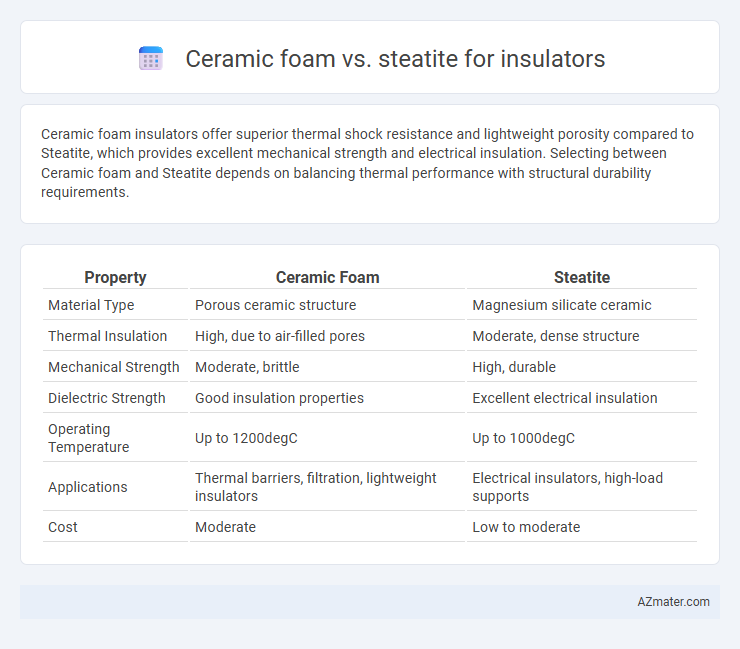Ceramic foam insulators offer superior thermal shock resistance and lightweight porosity compared to Steatite, which provides excellent mechanical strength and electrical insulation. Selecting between Ceramic foam and Steatite depends on balancing thermal performance with structural durability requirements.
Table of Comparison
| Property | Ceramic Foam | Steatite |
|---|---|---|
| Material Type | Porous ceramic structure | Magnesium silicate ceramic |
| Thermal Insulation | High, due to air-filled pores | Moderate, dense structure |
| Mechanical Strength | Moderate, brittle | High, durable |
| Dielectric Strength | Good insulation properties | Excellent electrical insulation |
| Operating Temperature | Up to 1200degC | Up to 1000degC |
| Applications | Thermal barriers, filtration, lightweight insulators | Electrical insulators, high-load supports |
| Cost | Moderate | Low to moderate |
Introduction to Ceramic Foam and Steatite Insulators
Ceramic foam insulators offer high porosity and excellent thermal shock resistance, making them ideal for high-temperature applications requiring lightweight and effective heat insulation. Steatite insulators, composed primarily of magnesium silicate, provide superior electrical insulation, mechanical strength, and durability under high-voltage conditions, commonly used in electrical and electronic components. Both materials excel in insulating properties but differ in structural characteristics and specific industrial applications.
Material Composition and Manufacturing Processes
Ceramic foam insulators consist primarily of alumina and silica, formed through a foaming process that creates a lightweight, porous structure enhancing thermal insulation and mechanical strength. Steatite insulators are mainly composed of magnesium silicate, produced by pressing and firing compacted powder, resulting in a dense, high-strength material with excellent electrical insulation properties. The manufacturing of ceramic foam involves controlled foaming and sintering, while steatite relies on precise powder processing and high-temperature firing to achieve its characteristic hardness and durability.
Thermal Properties and Heat Resistance
Ceramic foam insulators exhibit superior thermal resistance with operating temperatures up to 1600degC, benefiting from their porous structure that offers excellent heat insulation and low thermal conductivity around 0.1-0.3 W/m*K. Steatite insulators, composed mainly of magnesium silicate, provide good heat resistance up to 1000degC and possess higher thermal conductivity near 3 W/m*K, resulting in less efficient thermal insulation compared to ceramic foam. The choice between ceramic foam and steatite depends on application-specific requirements for maximum temperature tolerance and thermal insulation efficiency.
Electrical Insulation Performance
Ceramic foam offers superior electrical insulation performance due to its high porosity and low dielectric constant, minimizing electrical conductivity and enhancing resistance to dielectric breakdown. Steatite insulators, while durable and thermally stable, have a higher dielectric loss compared to ceramic foam, making them less efficient in high-frequency applications. The choice between ceramic foam and steatite depends on the required insulation strength, operating frequency, and thermal conditions of the electrical system.
Mechanical Strength and Durability
Ceramic foam insulators exhibit superior mechanical strength due to their interconnected porous structure, providing excellent resistance to compressive forces and thermal shock. Steatite insulators, composed of dense magnesium silicate, offer high durability with excellent electrical insulation properties and resistance to wear and moisture. While ceramic foam excels in lightweight applications requiring impact resistance, steatite is preferred for environments demanding long-term stability and consistent mechanical performance under varying conditions.
Porosity and Density Comparison
Ceramic foam insulators exhibit high porosity, typically ranging from 60% to 90%, resulting in lower density values around 0.2 to 0.6 g/cm3, which enhance thermal insulation by trapping air within the porous structure. Steatite, a dense ceramic material, has significantly lower porosity, often below 5%, with densities approximately 2.7 to 2.9 g/cm3, providing excellent mechanical strength and electrical insulating properties but with less inherent thermal insulation compared to ceramic foam. The distinct differences in porosity and density between ceramic foam and steatite make the former ideal for lightweight, high thermal resistance applications, while steatite suits environments requiring durable, compact insulators.
Applications in Electrical and Industrial Sectors
Ceramic foam insulators provide superior thermal resistance and lightweight properties, making them ideal for high-temperature applications in power plants and electrical furnace linings. Steatite insulators offer excellent electrical insulation and mechanical strength, commonly used in electronic components, high-voltage insulators, and industrial heating elements. Both materials serve critical roles in electrical and industrial sectors by enhancing durability, safety, and efficiency in demanding environments.
Cost-Effectiveness and Market Availability
Ceramic foam insulators offer greater cost-effectiveness due to lower raw material expenses and simplified manufacturing processes compared to steatite, which involves higher production costs from dense, high-purity mineral requirements. Market availability favors ceramic foam, widely used in industrial thermal insulation with abundant suppliers, whereas steatite remains niche, primarily found in specialized electrical insulators and limited commercial distribution. The choice between ceramic foam and steatite hinges on budget constraints and application-specific insulation demands, with ceramic foam dominating where affordability and bulk supply are critical.
Environmental Impact and Sustainability
Ceramic foam insulators exhibit lower environmental impact due to their production from abundant natural resources and superior recyclability compared to steatite, which relies on mining talc, leading to habitat disruption and higher energy consumption. The porous structure of ceramic foam enables energy-efficient thermal insulation, reducing operational carbon footprints in industrial applications. Steatite's durability is offset by limited recyclability and higher embodied energy, making ceramic foam a more sustainable choice for eco-conscious insulation solutions.
Choosing the Right Insulator: Ceramic Foam vs Steatite
Ceramic foam insulators offer superior thermal shock resistance and lightweight properties, making them ideal for high-temperature applications requiring rapid heat dissipation. Steatite insulators, composed primarily of magnesium silicate, provide excellent mechanical strength and electrical insulation, suited for environments with high mechanical stress and electrical demands. Choosing between ceramic foam and steatite depends on specific application parameters such as thermal conductivity, mechanical durability, and operational temperature range, with ceramic foam favored for thermal insulation and steatite preferred for robust electrical insulators.

Infographic: Ceramic foam vs Steatite for Insulator
 azmater.com
azmater.com